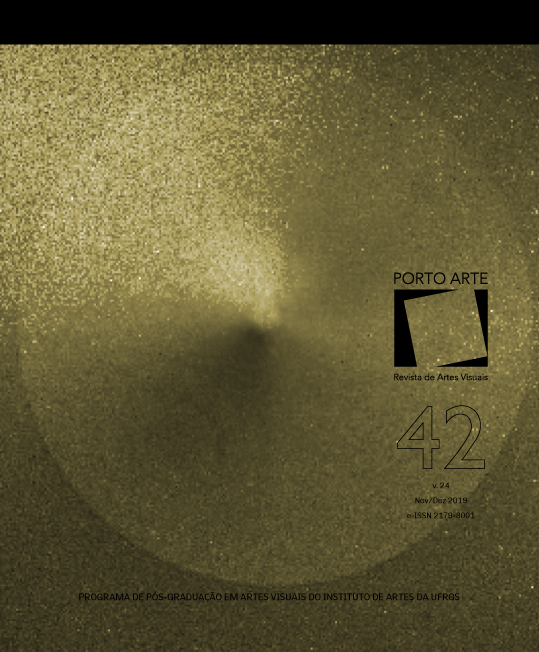Spectral Violence: Art and Disappearance in Post-Ayotzinapa Mexico
DOI:
https://doi.org/10.22456/2179-8001.104676Keywords:
Mexico, Contemporary Art, Ayotzinapa, Disappearance, Memory, Human RightsAbstract
In Mexico, memory has become a battlefield nowadays. The Ayotzinapa case (2014) –a still unresolved State-level human rights violation, including the disappearance of 43 students– transformed the public space into a permanent struggle between governmental amnesia and the politics of truth. With the emergence of various massive clandestine graves all across the country, a new form of violence emerged, characterized by the spectral materiality of the absent body. In this article, I elaborate on the relation between disappearance, social memory, and creative activism in recent Mexican art. Using the investigations of Forensic Architecture in Mexico as a case study, the text discusses the role of visual culture in the articulation of what I call the performativity of human rights.
Resumo
No México contemporâneo, a memória virou um campo de batalha. O caso Ayotzinapa (2014) –uma violação de direitos humanos orquestrada pelo Estado e ainda não resolvida, incluindo a situação de 43 estudantes ainda desaparecidos– transformou o espaço público em uma luta permanente entre a amnésia governamental e as políticas da verdade. O surgimento de fossas comuns clandestinas em todo o país propiciou também uma nova forma de violência caracterizada pela materialidade espectral do corpo ausente. O artigo pesquisa a relação entre desaparecimento, memória social e ativismo criativo na arte mexicana recente. Usando as investigações da Forensic Architecture no Mexico como estudo de caso, vamos analisar o papel da cultura visual na articulação do que o autor descreve como a performatividade dos direitos humanos.
Downloads
References
Barriendos, Joaquin. “Spectral Topographies: Fosses, Aesthetics and the Politics of Truth in Mexico” [paper presented during at the Musée d’art contemporain de Montréal on March 31, 2017, as a part of the International Symposium on Topographies of Mass Violence’, organized by the Université du Québec à Montréal (UQAM)].
Baskin, Deborah R. Ira B. Sommers. “Crime-Show-Viewing Habits and Public Attitudes Toward Forensic Evidence: The "CSI Effect" Revisited” in: The Justice System Journal, Vol. 31, No. 1 (2010), pp. 97-113.
Bois, Yve-Alain, Michel Feher, Hal Foster and Eyal Weizman. “On Forensic Architecture: A Conversation with Eyal Weizman” in: October, No. 156, (Spring, 2016), pp. 116–140.
Joyce, Christopher, Eric Stover. Witnesses from the Grave: The Stories Bones Tell. Little Brown & Co, 1991.
Junger, Sebastian. “The Forensics of War” in: Vanity Fair, October, 1999.
Keenan, Thomas. “Counter-forensics and Photography” in: Grey Room, No. 55, (Spring 2014), pp. 58-77.
Nora, Pierre. “Between memory and history: les Lieux de Mémoires” in: Representations, No. 26, 1955, pp. 7-24.
Rancière, Jacques. “Intolerable Image” in: The Emancipated Spectator. New York, Verso: 2009.
Sekula, Allan. “Photography and the Limits of National Identity” in: Grey Room, No. 55, (Spring, 2014), pp. 28-33.
Sicilia, Javier. “Las fosas de Jojutla: otro crimen pendiente” in: Proceso, (August 6, 2016).
Steyerl, Hito. “Missing People: Entanglement, Superposition, and Exhumation as Sites of Indeterminacy” in: The Wretched of the Screen. Berlin: Sternberg Press, 2012, pp. 138-159.
Weizman, Eyal, Anselm Franke. Forensis: The Architecture of Public Truth. Berlin: Sternberg Press, 2014.
Weizman, Eyal, Thomas Keenan. “The Image is the Bone” in: Mengele's Skull: The Advent of A Forensic Aesthetics. Berlin: Sternberg Press, 2012.
Weizman, Eyal. Forensic Architecture: Violence at the Threshold of Detectability. New York: Zone Books, 2017.
Additional Files
Published
How to Cite
Issue
Section
License
Autores que publicam nesta revista concordam com os seguintes termos:
Autores mantêm os direitos autorais e concedem à revista o direito de primeira publicação, com o trabalho licenciado sob a Creative Commons Atribuição-NãoComercial-CompartilhaIgual 4.0 Internacional (CC BY-NC-SA 4.0).
Autores têm autorização para assumir contratos adicionais separadamente, para distribuição não exclusiva da versão do trabalho publicada nesta revista, como publicar em repositório institucional, com reconhecimento de autoria e publicação inicial nesta revista, quando for o caso.
Os artigos são de acesso aberto e uso gratuito, com atribuições próprias em atividades educacionais, de pesquisa e não comerciais.


